What Is Pulp Fiction, and Who Cares?
Posted by Rampant Coyote on June 30, 2016
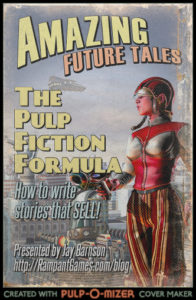 A few weeks ago at local convention, I gave a short presentation on the “pulp fiction formula,” referencing the Lester Dent “Pulp Fiction Master Plot Formula.” When I talk about this, one of the first questions I receive is “What is pulp fiction?” Which comes with the implied question, “Why should I care?”
A few weeks ago at local convention, I gave a short presentation on the “pulp fiction formula,” referencing the Lester Dent “Pulp Fiction Master Plot Formula.” When I talk about this, one of the first questions I receive is “What is pulp fiction?” Which comes with the implied question, “Why should I care?”
Now, I don’t consider myself an expert, just someone who might have done more research and read a bit more than average. But it’s enough that I get a little annoyed at some of the references to pulp fiction today, usually referring to it as a title of derision. A story is “just” pulp fiction, or something. I suspect that most of the time the person making the reference really isn’t familiar with it, and have only heard that the pulps were simply cheap, low-quality sources of lurid, hastily-crafted tales. And — okay, this far, they would probably correct. But there are implications there that, at least in my mind, are false. Well, partly false.
Sure, the pulps had a lot of crappy stories. So do libraries. They were also the source of a ton of classics and some of the most respected writers of their era. So… I guess we need to go back to the question, “What is pulp fiction?” I apologize if I get details wrong or oversimplify things, but hopefully it’ll be at least somewhat educational.
The Pulp Era
The simple, historical answer is that pulp fiction consists of stories that were published in pulp magazines, which were popular from the late 1800s until around the 1950s. They lost popularity at pretty much at the same time as other forms of entertainment gained dominance, like television. The pulp magazines were printed on cheap, low-quality paper made from wood pulp. Think comic-book paper, or maybe even newsprint. Before the digital era, that was about as cheap as you got.
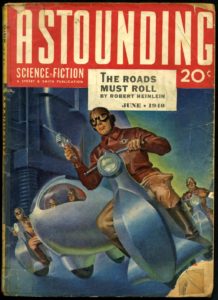 Unlike the more expensive “slicks” and other sources of entertainment, the pulps catered to the common man. They were cheap and exciting, full of stories for folks who just wanted to be entertained. The pulps were the home of “genre fiction” – pop fiction, with an emphasis on plot-driven stories. They were where most stories in certain “genres” were published… science fiction war stories, mysteries, romance, etc. With them, the market for stories expanded. And for the average working-class author, the pulps were where you made your rent. They WERE the market. They weren’t high-paying, but they’d pay. There were a lot of them… with new ones appearing all the time as the old ones ceased publication. And they’d print everything from short stories to full-length novels (which averaged a bit shorter then than they do now).
Unlike the more expensive “slicks” and other sources of entertainment, the pulps catered to the common man. They were cheap and exciting, full of stories for folks who just wanted to be entertained. The pulps were the home of “genre fiction” – pop fiction, with an emphasis on plot-driven stories. They were where most stories in certain “genres” were published… science fiction war stories, mysteries, romance, etc. With them, the market for stories expanded. And for the average working-class author, the pulps were where you made your rent. They WERE the market. They weren’t high-paying, but they’d pay. There were a lot of them… with new ones appearing all the time as the old ones ceased publication. And they’d print everything from short stories to full-length novels (which averaged a bit shorter then than they do now).
Genre fiction in mass-market paperbacks (the successors to “dime novels”) were often reprints from magazines, printed on the same low-quality pulp paper. So referencing the “pulps” applies equally well to genre fiction novels of the era.
The Pulp Authors and Market
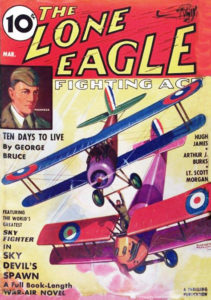 The editors of these magazines had to build a consistent audience based on the overall quality and the genre of their stories. Their audience would buy a particular magazine because it had stories like ones they’d previously enjoyed, or authors they’d previously enjoyed. Gee, sounds like some universal realities here, right? “Air Wonder Stories” differentiated itself from “Air Adventures” by printing stories with more of a science fiction and futuristic twist to the aviation adventures. But the bottom line was that they had to print something like 135,000 words every month, every other month, or every quarter. They needed stories that would appeal to the mass market (insofar as their genre specialization would allow), they needed a lot of them, and they needed them cheap.
The editors of these magazines had to build a consistent audience based on the overall quality and the genre of their stories. Their audience would buy a particular magazine because it had stories like ones they’d previously enjoyed, or authors they’d previously enjoyed. Gee, sounds like some universal realities here, right? “Air Wonder Stories” differentiated itself from “Air Adventures” by printing stories with more of a science fiction and futuristic twist to the aviation adventures. But the bottom line was that they had to print something like 135,000 words every month, every other month, or every quarter. They needed stories that would appeal to the mass market (insofar as their genre specialization would allow), they needed a lot of them, and they needed them cheap.
So… you end up with the sort of situation we have today with “indie” digital publishing, only not quite as saturated.
The market reality rewarded the authors who could write fast, who could write sufficiently well, and could tell an entertaining yarn of an arbitrary size. A reputation for all of the above (plus some level of professionalism) would put the author in good standing with editors, which made everybody’s job easier. Several famous / influential / popular pulp fiction authors include Raymond Chandler, H. G. Wells, Edgar Rice Burroughs, Max Brand, H.P. Lovecraft, Dashiell Hammett, Ray Bradbury, Leigh Brackett, Robert E. Howard, Lester Dent (known more frequently by his pen name Kenneth Robeson), Michael Moorcock, James M. Cain, Richard Matheson, Jim Thompson, Fritz Lieber, Robert A. Heinlein, L. Ron Hubbard (yeah, the Scientology guy), Phillip K. Dick, L. Sprague de Camp, Isaac Asimov, Poul Anderson, and James Blish. Many of these folks went on to become influential in the “literary fiction” arena as well. And while their careers may have evolved past the pulps (especially once the pulp era came to an end), many of their best-known works were first printed in pulp magazines or in pulp paperbacks.
The Pulp Style, Quality, and Influence
 There’s a style associated with the pulps these days that might be more appropriately associated with fiction of the time period rather than where they appeared. The characters use the slang of the day. Writing styles have evolved a lot too. Things that are strongly discouraged in modern fiction (like excessive adverbs, dialog tags, and passive voice) are on full display.
There’s a style associated with the pulps these days that might be more appropriately associated with fiction of the time period rather than where they appeared. The characters use the slang of the day. Writing styles have evolved a lot too. Things that are strongly discouraged in modern fiction (like excessive adverbs, dialog tags, and passive voice) are on full display.
Some of the genres – like aviation stories – derived from the public fascination in the exciting new technology and its impact on modern (for the time) life. Westerns were popular because they spoke to an idealized view of the American frontier in a time that wasn’t that far distant… sort of like us in the modern era talking about the 1950s or even the 1980s. The stories and characters represented the culture of their era, even when projected into the distant past or future. Modern stories do the same.
This also means they reflect the mores and social traditions of the author’s culture, which some modern readers might find impedes their enjoyment. While readers expecting rampant racism and sexism will certainly find it, readers might be equally surprised by how downright and sometimes subversively… well, progressive… many stories are. Especially when one considers they were printed in an era of civil rights strife and when the government encouraged women to return to their “place” in the home, so that returning soldiers could get back to their relatively high-paying jobs that the women had performed during the war.
Every genre has its own quirks, but in general, pulp stories were lurid, action-oriented, and imaginative. After all, they had to provide novelty to readers in every issue! Characters were simple but interesting. They didn’t stand out with too many weird quirks most of the time. Instead, they tended to be more of a reader surrogate, so that any reader could identify with them and easily project themselves into the character. Ultimately, the stories were written to be “crowd-pleasers.” They make up for their lack of subtlety with imagination… even in the somewhat more down-to-earth genres.
Another interesting feature is the number of short stories featuring the same characters. Doc Savage and his crime-fighting team, Conan, Mike Hammer, Tarzan, Eric John Stark, Perry Mason, The Shadow, Sherlock Holmes, John Carter, Elric of Melnibone, Solomon Kane, Philip Marlowe… The list goes on. This isn’t very different from how book series are handled today, except where these characters made repeat appearances in short stories rather than novels.
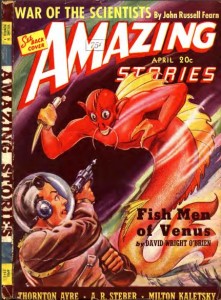 As to quality… it runs the gamut. Seriously. Even within the same issue. Things are a little easier if you read an anthology that may be more of a “best of” from a particular magazine or author. But going on the basis of an average issue… saying that “not every story is a gem” would be an understatement. But that’s not saying that the stories are terrible, either. Yeah, I made fun of Fish Men of Venus, and I wish I could say it is unusually bad. It’s not. There are worse. But there are also much better.
As to quality… it runs the gamut. Seriously. Even within the same issue. Things are a little easier if you read an anthology that may be more of a “best of” from a particular magazine or author. But going on the basis of an average issue… saying that “not every story is a gem” would be an understatement. But that’s not saying that the stories are terrible, either. Yeah, I made fun of Fish Men of Venus, and I wish I could say it is unusually bad. It’s not. There are worse. But there are also much better.
Some of what might seem quality issues would be what seems tired or obvious plot devices or twists, but that’s also a factor of the stories having inspired generations of imitators, in literature, cinema, video games, you name it. Some of this was also dictated by story size. If you have a detective story with only three main characters – the protagonist, the protagonist’s partner, and the obvious guilty party – it’s pretty obvious what the “surprise twist” at the end will be.
Almost by definition, these stories are, collectively, “Average” for the period in quality… simply because the sheer quantity of pulp fiction skews the curve. The pulp masters deduced a lot about how to tell a good, entertaining story over time, and developed successful patterns (Dent called it a “formula,” but I don’t think it’s quite that well-defined) that met the audience need. Much of what we now know about writing came from trial-and-error in these kinds of stories. Even if many of these stories wouldn’t pass editorial muster today, it’s because we’ve got easy-to-read signposts along the trail that they blazed.
Old Pulp, New Pulp, and Reading Pulp Today
Are these old stories worth reading today? In some cases, yes, absolutely. Many pulp-era stories have deservedly become classics. There are many more lesser-known gems to be found in the pages of these old magazines. Some of the authors were extremely skillful wordsmiths and are a delight to read. Some are simply imaginative and have incredibly fascinating worlds to explore. Some are both. Unfortunately, due to the age of the magazines, they can be hard to find, and finding any kind of reviews or filters can be harder that finding the stories themselves.
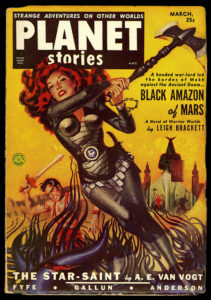 Your best bet is to find anthologies by some of the pulp masters mentioned above. These tend to be more of a “best of” collection in the first place, which is nice. Even the best authors don’t hit home runs every time. If your local library doesn’t have them, Amazon frequently does, especially in ebook format.
Your best bet is to find anthologies by some of the pulp masters mentioned above. These tend to be more of a “best of” collection in the first place, which is nice. Even the best authors don’t hit home runs every time. If your local library doesn’t have them, Amazon frequently does, especially in ebook format.
Because of the cheap paper used, pulp books don’t age well. It’s hard to find the originals, and the publishers aren’t around to issue reprints. You can find some on EBay and Amazon, but expect to fork over some cash for something that’s probably not in great condition.
Digital archives exist for some issues, but many may be lost to antiquity. Because of reprints and copyrights, some of the stories may not be legally reproduced yet, but the low-quality media means there may be no surviving copies to digitize before it’s legally free-and-clear to do so. That’s the bad news. The good news is… there’s a lot out there.
The most legally scrupulous source I know of is the Pulp Magazine Project, which not only has issues (or partial issues, where parts are not in the public domain) for download, but tons of articles, history, lists, photographs, and so forth. It has far more information than I have here, and they know their fiction magazine history *WAY* than I do. It’s great stuff, but I’m not sure how actively it’s being updated. They do post fairly regularly (if not super-frequently) on their facebook page.
Pulp Covers is exactly what it says on the tin. They are regularly adding new covers, which are just fun to look at. They also have links back to where that particular issue may be available… often EBay or Amazon for the physical copy, or a digital archive. As an author, just digging through some of that old cover art can be inspiring. But mostly, it’s fun. I take some small exception to their tagline, “The Best Of The Worst,” but… Okay. Let’s be honest. Before there were clickbait links, there were magazine covers…
A fantastic digital source if you don’t mind drinking from the fire hose is the Pulp Magazine Archive.
That’s the old, classic pulp.
But pulp ain’t dead.
The “pulp” legacy is very much alive today. But since this article is about 3x longer than I intended it to be at this point, I’m going to talk about that topic later.
Filed Under: Retro, Short Fiction - Comments: Read the First Comment
The Pulp Legacy: Modern Pulp Fiction said,
[…] My previous post was all about classic “pulp” fiction from the late 19th century up through the middle of the 20th century. But then… it died out. Maybe not as dead as disco, but that particular form faded into the background. The rise of easier, more accessible entertainment probably accounted for much of it. […]